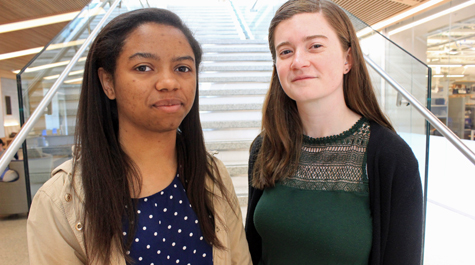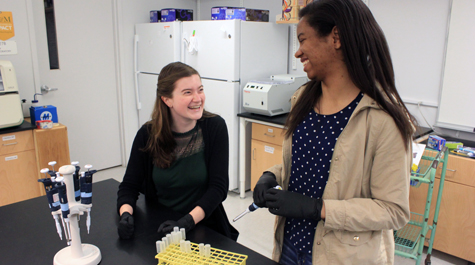Freshman lab mates turned NSF fellows
Kalen Clifton and Elizabeth Ransone were first introduced as freshmen while working aviary duty at the Institute for Integrative Bird Behavior Studies. Fast-forward four years and the recent graduates will soon enter into research careers, each backed by a strong vote of confidence from the National Science Foundation.
Clifton and Ransone were selected from a field of over 12,000 applications for the NSF’s prestigious Graduate Research Fellowships – a three-year award that offers financial support to underwrite graduate study toward a master’s or doctoral degree in a STEM field. “It was a total shock,” said Ransone. “I know the statistics behind actually getting it, especially as an undergrad – they’re not great.”
At W&M, our collaborative philosophy extends to the involvement of undergraduates in research at the highest levels. It's quite common to find projects on which professors, post-docs, graduate students and undergraduates all work together.
As freshmen, Clifton and Ransone studied mercury as an environmental stressor of songbirds under the guidance of two biology professors. Both students have research interests in microbiology, but they’re on opposite sides of the spectrum when it comes to analyzing change over time. Ransone has focused her studies on mutations that occur over the long term, during millions of years of evolution. Clifton has zeroed in on shorter-term mutations, like those that occur in tissue engineering.
Clifton will continue to pursue her research interests in the biomedical engineering Ph.D. program at Johns Hopkins University, while Ransone is delaying her fellowship start by one year to complete a Fulbright in Germany. She plans to spend the next year studying bacterial symbiosis, specifically Xenorhabdus bacterial mutants, at Goethe University in Frankfurt.
Ransone aims to eventually study arboviruses like zika and dengue. Her goal is to understand how viruses work with their host to infect humans and hopes to one day partner with bioengineers like Clifton to find clinical applications for her research.
“I’d like to look at how we can possibly modulate that interaction,” Ransone said. “I want it to get to the point where I can hand my research off to Kalen and she can do her magic. That’s my hope.”
At William & Mary, our research culture places an emphasis on quality, selectivity and innovation. Research opportunities for undergrads are plentiful, but many projects get filled. Here's some advice:
- Ask! If you know a professor who is doing research (and most of them are), ask to get involved.
- Remember, you can do research outside your major.
- Check out the opportunities available through The Roy R. Charles Center for Academic Excellence.
















